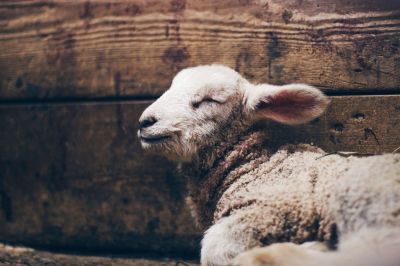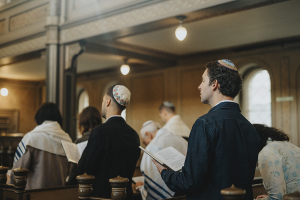The cedar, the hyssop, the Lamb and the blood

As we enter into the season of Passover and commemorate Jesus’ crucifixion and His miraculous resurrection, a closer look at the elements associated with these events reveals a profoundly spell-binding image.
See for yourself.
The hyssop and the cedar
Among King Solomon’s accomplishments and the depth of knowledge he acquired, 1 Kings 4:33 acknowledges, “He spoke of trees, from the cedar that is in Lebanon even to the hyssop that grows on the wall …”
The significance is this:
“The cedar and hyssop are placed in antithesis, the former as the largest and most glorious of trees, the latter as the smallest and among the most insignificant of plants …”
Hyssop is a flowering plant common in the Middle East and Southern Europe that grows to about 18 inches tall, often boasts white, purple, or blue flowers and it is known for its medicinal, antiseptic and calming properties. It is reported to have an intense, minty aroma, although other sources refer to a licorice-like smell. The plant is tolerant of chalky, sandy soils and thrives in full sun and warm climates. It is a common shrub, perhaps symbolic of humanity, yet the colors may hold symbolic value.
White generally represents holiness or glory, while blue symbolizes Heaven and purple — royalty. In this, we may see our holy heavenly King disguised as one who was seemingly ordinary.
“For He grew up before Him like a tender shoot, and like a root out of parched ground; He has no stately form or majesty that we should look upon Him, nor appearance that we should be attracted to Him” (Isaiah 53:2).
The first mention of hyssop occurs in the Book of Exodus, when God’s final plague against Egypt was imminent. At God’s direction, Moses instructed every Hebrew family to keep a spotless lamb in their home for three days and to sacrifice it on the fourth day. A hyssop branch was then dipped in the lamb’s blood, and the blood was applied to the doorposts and lintels of each home and its inhabitants were to remain in their homes until the death angel had “passed over.”
The first Passover was not merely a test of faith, but a foreshadowing of Jesus’ ultimate embodiment of the one true Lamb sacrificed for our eternal deliverance.
The cedar
“Cedar is a tree of the pine family frequently mentioned in the Old Testament ... The cedar-tree grows best in a high, dry, and sandy region, and it found these requirements in the northern part of Palestine in the Lebanon district. In this district there are to be seen trees that reach a girth measurement of no less than 42 feet. The tree spreads its roots among the rocks, and thus secures a strong hold.” [1]
The 39 mentions of cedar in the Old Testament all reference its use in the construction of magnificent structures or as a descriptor of men of moral or physical strength:
“The righteous man will flourish like the palm tree, he will grow like a cedar in Lebanon” (Psalm 92:12).
It is also possible that “gopher wood” as referenced in the construction of Noah’s ark was actually cedar. A Jewish encyclopedia states:
“The word ‘gofer’ occurs but once in the Bible. … The renderings proposed by modern interpreters are as a rule arbitrary and unsatisfactory.
“… Others think that ‘gofer’ can best be explained from the Assyro-Babylonian literature. Cheyne, starting from the assumption that the Hebrew narrative of the Deluge is a mere translation from some similar Babylonian document, supposes that the passage under discussion read in the original ‘gushure iṣ erini’” (cedar-beams).[2]
So perhaps Noah’s ark was constructed with cedar, a symbol of exceptional strength. This may explain why cedar was predominantly used in the construction of not only the temple but King David’s palace, as well.
“Then Hiram king of Tyre sent messengers to David with cedar trees and carpenters and stonemasons; and they built a house for David” (2 Samuel 5:11).
Next, we see the use of hyssop, cedar, a sacrificial bird, and its blood in a Mosaic ritual affirming the cleansing of a leper.
Two birds were brought before a priest. One bird is slain in an earthenware vessel over running water. Then the live bird and the hyssop are bound to the cedar plank with the scarlet thread and dipped into the blood of the sacrificed bird. The healed leper was sprinkled with the blood seven times (the number signifying completion or fulfillment) and the bird is released. So, one bird died, and the live bird was dipped in its blood and set free.
In Matthew 18:1-4, Jesus encouraged adherence to this ritual in His encounter with a leper.
“... a leper came to Him and bowed down before Him, and said, “Lord, if You are willing, You can make me clean. Jesus stretched out His hand and touched him, saying, ‘I am willing; be cleansed.’ And immediately his leprosy was cleansed. And Jesus said to him, ‘See that you tell no one; but go, show yourself to the priest and present the offering that Moses commanded, as a testimony to them’”(Matthew 8:2-4).
Perhaps Jesus’ words to the leper hinted at a soul-based healing far beyond the man’s immediate need: “Yes, my friend, I am willing to die for you so that you may be set free — forever.”
The Passover’s fulfillment
Finally, we see our Lord’s battered body nailed to a sinner’s cross. All four elements are essentially present — the spotless Lamb, the blood, the cedar and finally, the lowly hyssop. John’s record of what occurred in the final moments of Jesus’ earthly life reads:
“Jesus,knowing that all things had already been accomplished, in order that the Scripture might be fulfilled, said, ‘I am thirsty.’A jar of sour wine was standing there, so they put a sponge full of the sour wine upon a branch of hyssop and brought it up to His lips” (John 19:28-29).
John, the only disciple present to witness the event, records that only moments before Jesus breathed His last, a sponge dipped in sour wine was raised to His lips on a hyssop branch. Knowing hyssop’s fragrant properties, it rose before Jesus as the final element in Passover’s perfect fulfillment.
“It is finished!”
The Lamb had been sacrificed, and the curse of death was forever broken for those covered by the blood of the one and only sinless Lamb of God.
So, we see the incredible image in its fullness: The cedar, the hyssop, the Lamb and the blood — the scarlet thread that tied all of the elements together in amazing prophetic perfection.
“I have been crucified with Christ; and it is no longer I who live, but Christ lives in me; and the life which I now live in the flesh I live by faith in the Son of God, who loved me and gave Himself up for me” (Galatians 2:20).
[1]Jewish Encyclopedia, https://www.jewishencyclopedia.com/articles/4164-cedar. By: Morris Jastrow, Jr., Gerson B. Levi, accessed 3/29/22 (excerpts for brevity)
[2] https://www.jewishencyclopedia.com/articles/6808-gopher-wood. By: Emil G. Hirsch, Henry Hyyernat, accessed 3-29-22
Cindy Burrell is the owner of Hurtbylove.com, a web-based ministry to women in abusive relationships and the author of Why Is He So Mean to Me? She offers personal coaching/counseling to abuse victims.




























